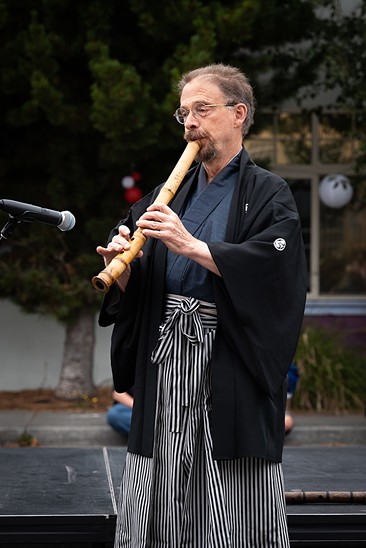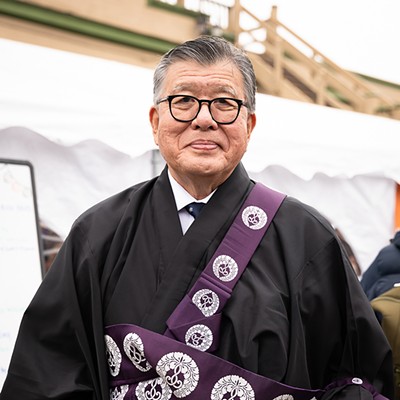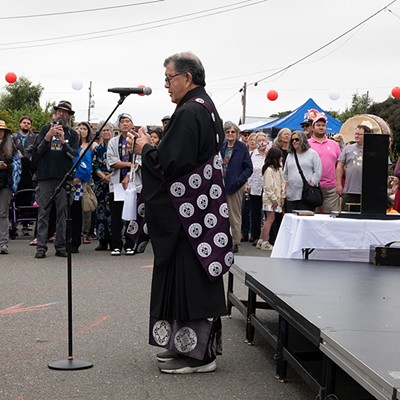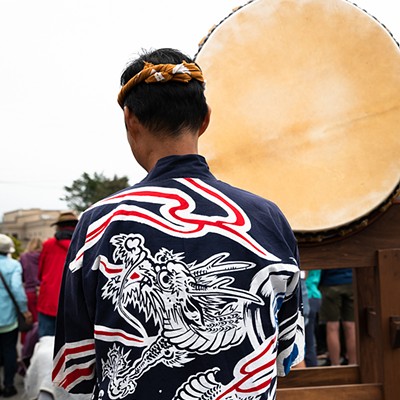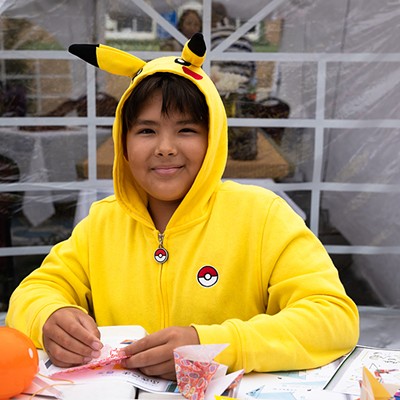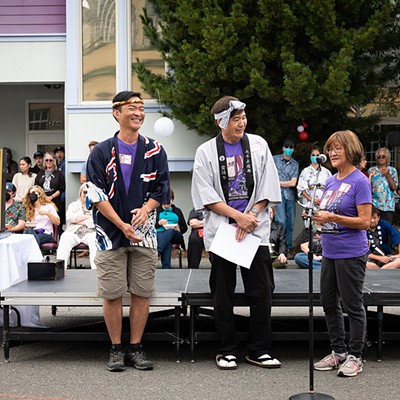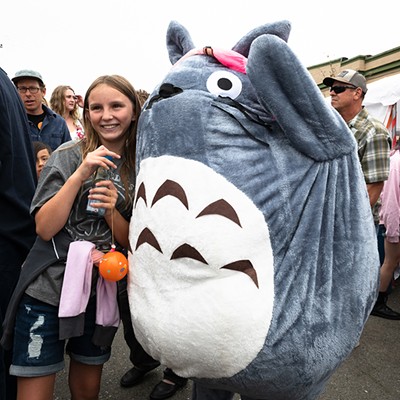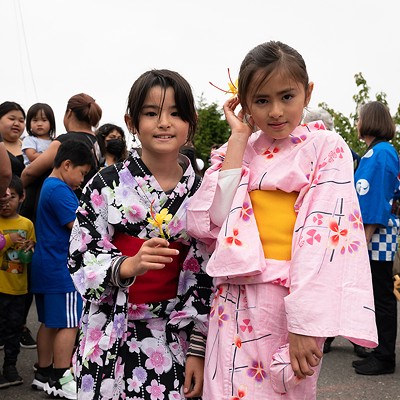Obon Humboldt Style
HAPI brings the first Japanese Obon festival to the county
By Jennifer Fumiko Cahill [email protected] @jfumikocahill[
{
"name": "Top Stories Video Pair",
"insertPoint": "7",
"component": "17087298",
"parentWrapperClass": "fdn-ads-inline-content-block",
"requiredCountToDisplay": "1"
}
]
People are still trickling into the lot in front of the Arcata Playhouse, thickening the crowd already encircling the low stage, where Marylyn Paik-Nicely, a "founding mother" of Humboldt Asians and Pacific Islanders in Solidarity (HAPI), stands in pink sneakers and a purple T-shirt commemorating this, the first Obon festival in Humboldt County, a cell phone in her back pocket. Some in the ring of attendees, both Japanese and non-Japanese, are wearing yukata (cotton summer kimono), festival hapi coats or kimono. Some of the kimono are perfectly arranged with artful contrasting bows, others are worn loosely over western clothes, some hang open like robes. But nobody seems to be fretting too much about it.
HAPI member Alex Ozaki-McNeill says the group wanted to encourage people to come out in whatever clothes spoke to their connection to Japanese culture. "Our general mindset is that we're inviting people to share our culture," she says, so they're not worried about cultural appropriation. The event — a "Humboldt-style" Obon festival with drumming, dancing, food and children's games — was planned as a chance for everyone to experience the annual tradition of connecting with one's ancestors.
Ozaki-McNeill finds the simplest way to explain Obon, a Japanese Buddhist celebration going back more than 500 years, in California is to draw parallels to the Mexican Dia de los Muertos. Despite their very different origins, both involve remembrance, care and feeding of departed family and loved ones. During Obon, when the spirits of the dead return, the living visit and clean their ancestors' graves and offer them food, placing photos, rice, fruit and favorite foods on a household altar alongside incense. Many Japanese add little wooden legs to a cucumber and an eggplant, symbolizing a fast horse to bring the spirits home and a slow cow for them to ride back to the afterworld. And out in town centers, there are festivals with bright paper lanterns and drum towers, atop which taiko drummers beat out a rhythm for circling dancers below.
Growing up in Humboldt County, where the Japanese American population is fairly small and dispersed, Ozaki-McNeill says her mother would take the family to the Bay Area to expose her and her brother to cultural events like Obon. "So this is really exciting to have something like this here." Before her grandfather died a few years ago, Ozaki-McNeill went to Japan with him. Honoring his ancestors at his family temple and connecting with relatives was "on his bucket list," she says. Now, with her own baby, she feels the importance of sharing the tradition with her daughter.
Back on stage, Gerald Sakamoto, head minister of the San Jose Buddhist Temple, tells a story from a sutra about a student who discovers his mother's spirit is trapped in the Realm of Hungry Ghosts, where food turns to ash and flames. When he asks his teacher how to free her, the teacher says he must help his fellow monks and the people in his community. The 2,500-year-old story, he says, demonstrates how important it is "that we recognize that relationship to those around us, that we are not isolated. ... Today ... [during Obon] it's not just Buddhists we should remember, or just our families, but all people in the world." As he prepares to chant, he looks at his feet and shrugs. "I forgot my dress shoes," he says, drawing a laugh from the crowd.
He begins the chant and the attendees fall silent under the steady thrum of his voice as red and white paper lanterns bob on the lines above the lot. A trio of children with striped water-filled balloons on elastic strings bounce them lightly. A toddler in a yukata and Hello Kitty sneakers fidgets by the bike rack. On the other side of the circle, an older man in a pale cowboy hat hooks his thumbs in his belt and listens.
Sakamoto usually plays to a bigger crowd. The Obon festival in San Jose this year, the first since lockdown in 2020, drew some 900 dancers alone. But he says he's pleased to be a part of Humboldt's first Obon. "It's wonderful to see all this interest, seeing people be a part of the community," an aspect that can get a bit lost in outsized events. He says he prepared his talk with the varying backgrounds of Humboldt folks in mind, especially the Wiyot Tribe on whose land the festival would take place. "Rather than focus on a particular religion, [I focused] on a connection to people and to place."
When the Humboldt Taiko drummers start playing, it's chest pounding, thundering down into the pavement. Some spectators hold phones aloft to record the seven drummers arcing their sticks overhead, knocking at the wooden sides and skins of their drums in sync for rolling crescendos. Teacher Gary Ronne's solo numbers are even more physical as he leaps and dances barefoot around his drum, veering from impishness to high drama and back again.
It was at a ramen fundraiser for Taiko Swing Humboldt in 2019 that the idea for a Humboldt Obon festival first sparked. The Swingposium that the group put on in January of 2020 in partnership with San Jose Taiko was both a sober retelling of the mass imprisonment of Japanese Americans during World War II and a joyful mashup of taiko and big band music and dance. But the momentum it created was stalled by the pandemic.
But as events started to return, the HAPI group that grew out of Taiko Swing Humboldt saw an opportunity to hold an outdoor festival. "In traditional HAPI fashion, we put it together in a couple months," says Ozaki-McNeill with a chuckle. "HAPI is definitely a pan-Asian group — a lot of our coordinators identify as Japanese American but we want to incorporate more events in Humboldt that include other Asian and Pacific Islander cultures." There's significant overlap between the Obon organizers, the Swingposium group and the Eureka Chinatown Project, which recently worked to establish wayfinding signs for the city's historic Chinatown and rename one of its alleys Charlie Moon Way in honor of a man who resisted the 1885 Chinese Expulsion ("Heading for Charlie Moon Way," Nov. 7, 2021). Ozaki-McNeill notes that Paik-Nicely, a presence in all these projects, has been the driving force behind the high-speed effort for the Obon festival.
"So many people came together from so many different [API] backgrounds, not just Japanese, some hakujin," Paik-Nicely says, using the typically neutral Japanese word for white people. She explains how Obon varies from Japan to America and between different regions and cities, so the group shared their favorite memories to figure out what elements to incorporate.
Paik-Nicely, who grew up Korean and third generation Okinawan in Japanese-influenced Hilo, Hawaii, recalls Obon as a season running from July into August. "Every Saturday there was a bon dance at a different [Buddhist] church," as well as at Shinto shrines. "When I was younger, it was more like watching my aunties and learning the dances," but in high school it became a social occasion. She has happy memories of driving her grandmother to the graveyard, where she'd walk from plot to plot, leaving gifts and telling stories about each friend and relative. "Each time, after, I just felt so good."
Even far away in Humboldt, Paik-Nicely says, "I always know when it is Obon ... I always have an altar up anyway with pictures of my parents and grandparents just to feel in touch." But without a Buddhist temple, sharing the season with others was difficult. Bringing Obon to Humboldt also connects to what she sees as a resurgence of Japanese American cultural practice. "After the internment and WWII ended, it was just so important for [second generation Japanese Americans'] kids to be 'American' and assimilate," she says, taking American names and speaking only English, even if they attended Japanese language class. "The third generation is like, 'Hey, we're gonna reclaim our heritage.'"
HAPI is a Dreammaker Project of the Ink People, through which it establishes its nonprofit status and event insurance. Humboldt Area Foundation came through with a grant for event costs and HAPI got help with kitchen space at the Arcata Playhouse, tables, the stage and sound equipment through a city of Arcata event grant. The group set a budget of $8,000 on its crowdfunding page and was thrilled when a single donor put in about half that. The permit HAPI secured was for 400 people — a wild guess for the first-time event. Though there's no formal headcount, attendance was in the hundreds.
When Paik-Nicely first contacted Craig Kurumada about heading up the bon dancing, he says he "was very dubious."
"You know, I just thought, 'OK, we don't have a temple, or a priest and a really tiny Japanese community, but other than that,'" he trails off with a laugh. But he says HAPI had so much "energy and positive forward motion," he got on board. Kurumada, a stalwart of the local folkdance community who specializes in Balkan dance, had taught bon dancing through the Osher Lifelong Learning Institute. He set an ambitious goal of eight dances for the Redwood Raks classes, all of which he learned as a kid in Salt Lake City. In the end, it yielded a core group of more than a dozen dancers who could lead others joining in at the festival. He also put tutorials online so people could practice at home.
"There was a great deal of interest from non-Japanese," and as he wondered why, Kurumada saw the irony. "Here I am as an Asian American and I'm always interested in all these other dances." Often asked why he studies Balkan dance when he's not Bulgarian, he replies he loves the music and the movement, and "it speaks to my heart."
Kurumada's own family, which is Japanese and Chinese, was never particularly into Obon. But that spoke to his heart, too — he was drawn to the gatherings and the dances as an elementary student and joined the practices months ahead of the festivals. "When I moved here, of course, there was no opportunity to do it." For 30 years, he traveled to the Bay Area if he wanted to take part.
As much as he loves traditional dance, Kurumada is not a hardcore purist, like some in the folkdance world who he says hope to "freeze things in time" instead of letting traditions evolve. "It's a growing, organic tradition; it's not just preservation. They're making new dances all the time."
Paik-Nicely echoes the sentiment, noting HAPI's festival is "Obon Humboldt style. Many things won't be like you'll find in other places but we're making it the way we want it to be." In the spirit of community participation, Kelley Garrett found inspiration in the wooden ema plaques visitors hang at Shinto shrines and the strips of paper with wishes on them that adorn bamboo trees during Tanabata, also known as the Star Festival. Garrett brought her own young cherry tree with a few redwood branches at the base and set out paper for attendees to write messages for ancestors to hang in the branches.
After a Totoro mascot warms up the crowd, the bon dancing begins. Kurumada, fan in hand, and Ronne, drumming along to the piped in music, lean into their showmanship on stage, grinning and capering as two rings of dancers travel around them. Those who'd taken the class take the inside track, with newcomers following along, some laughing and stumbling, others mimicking with sober attention. When the music cuts out a moment, Ronne keeps the beat going a bit and the dancers continue their path to applause from the crowd.
Dressed in black and pink floral yukata, Leslie Sweeney-Fern watches with a friend. "I was late because I was trying to tie my obi right." Her son had gone to Japan for a year of study abroad "and didn't come home," she says, smiling. While she's visited Japan, it's never been during Obon. "I think it's fantastic ... it's a real feel-good event."
Yoshiko Skelton is surprised by the turnout, though she's always found Humboldt welcoming. Originally from Kyoto, she moved to Humboldt in 1973 from Tokyo, where she worked. "Almost a native," she says from the chair someone brought her earlier. In all those years, she's never seen a festival like this. "This is very good ... a good atmosphere," she says, eyes on the dancers, adding how much she enjoyed the taiko performance. She says she won't dance because of a bad back but eventually she drifts into the outer circle.
When the music ends, Jim Hatchimonji straightens his fedora and regroups with his wife Rachel and daughter Emi, a straw fan tucked in his belt. "We've gone to Obon festivals in Hawaii and Gardena," he says, though this is his daughter's first time dancing.
Rachel Hatchimonji says the family has always had to travel if they wanted to attend something like this and she's happy "just getting to have one of the Japanese festivals here."
"We didn't know there would be such an outpouring of people," says Kurumada, who took in the crowds with disbelief. In recent years, particularly over the course of the pandemic, anti-Asian rhetoric and violence have ramped up, adding to both the surprise and meaning of such a well-attended and diverse Obon gathering. "Of course, there was this whole period of 'Asian-free' Humboldt; I mean it's pretty awful," Kurumada says, referring to the Chinese Expulsion of 1885 and its aftermath. "I had no idea not only how many Japanese and Asian people are here but also Asian-connected people ... and families." Add to that all those with no connection, who simply wanted to learn about Obon.
"I was overwhelmed," says Paik-Nicely, who was moved by the attendance, as well as the number of people who came out in some form of Japanese dress. (The food vendors were overwhelmed, too, with the Obento stall, Jim Hito's curry stand and the table selling omusubi with Spam or tofu between layers of rice running out entirely.)
"I think for us to have the Obon festival was a real celebration," says Paik-Nicely, "the community coming together and honoring our ancestors and honoring tradition." These were always the goals. But there are other joys from the day for her, like her grandson "asking all kinds of questions," and joining the bon circle, enjoying the movement, dancing with his fan.
Jennifer Fumiko Cahill (she/her) is the arts and features editor at the Journal. Reach her at 442-1400, extension 320, or [email protected]. Follow her on Twitter @JFumikoCahill.
Speaking of...
-

Valley West, Cannabis Taxes, Trail Access and Festivals
Oct 5, 2023 -
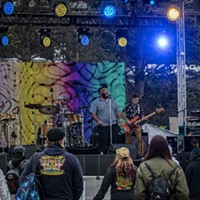
Photos: Cannifest Manifests
Sep 13, 2023 -
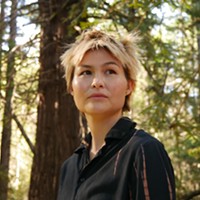
HAPI "Exploring Roots" Festival Opens Friday
Jun 22, 2023 - More »
more from the author
-
Eco Cemeteries, Flags, Impacts and Foods
- Apr 12, 2024
-
Sunken Seaweed's Dual Mission
Stocking shelves and the ocean with seaweed and kelp
- Apr 11, 2024
-
Alternative Energy Brainstorming with Billionaires
- Apr 11, 2024
- More »
Latest in News
Readers also liked…
-
Through Mark Larson's Lens
A local photographer's favorite images of 2022 in Humboldt
- Jan 5, 2023
-
'To Celebrate Our Sovereignty'
Yurok Tribe to host gathering honoring 'ultimate river warrior' on the anniversary of the U.S. Supreme Court ruling that changed everything
- Jun 8, 2023

